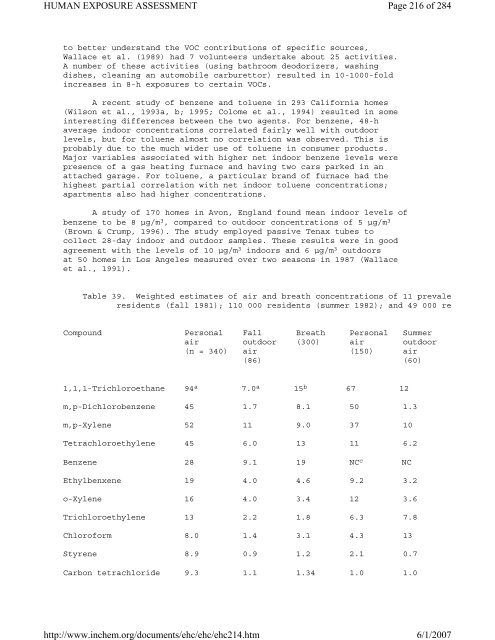Environmental Health Criteria 214
Environmental Health Criteria 214
Environmental Health Criteria 214
You also want an ePaper? Increase the reach of your titles
YUMPU automatically turns print PDFs into web optimized ePapers that Google loves.
HUMAN EXPOSURE ASSESSMENT<br />
to better understand the VOC contributions of specific sources,<br />
Wallace et al. (1989) had 7 volunteers undertake about 25 activities.<br />
A number of these activities (using bathroom deodorizers, washing<br />
dishes, cleaning an automobile carburettor) resulted in 10-1000-fold<br />
increases in 8-h exposures to certain VOCs.<br />
A recent study of benzene and toluene in 293 California homes<br />
(Wilson et al., 1993a, b; 1995; Colome et al., 1994) resulted in some<br />
interesting differences between the two agents. For benzene, 48-h<br />
average indoor concentrations correlated fairly well with outdoor<br />
levels, but for toluene almost no correlation was observed. This is<br />
probably due to the much wider use of toluene in consumer products.<br />
Major variables associated with higher net indoor benzene levels were<br />
presence of a gas heating furnace and having two cars parked in an<br />
attached garage. For toluene, a particular brand of furnace had the<br />
highest partial correlation with net indoor toluene concentrations;<br />
apartments also had higher concentrations.<br />
A study of 170 homes in Avon, England found mean indoor levels of<br />
benzene to be 8 µg/m 3 , compared to outdoor concentrations of 5 µg/m 3<br />
(Brown & Crump, 1996). The study employed passive Tenax tubes to<br />
collect 28-day indoor and outdoor samples. These results were in good<br />
agreement with the levels of 10 µg/m 3 indoors and 6 µg/m 3 outdoors<br />
at 50 homes in Los Angeles measured over two seasons in 1987 (Wallace<br />
et al., 1991).<br />
Table 39. Weighted estimates of air and breath concentrations of 11 prevale<br />
residents (fall 1981); 110 000 residents (summer 1982); and 49 000 re<br />
Compound Personal Fall Breath Personal Summer<br />
air outdoor (300) air outdoor<br />
(n = 340) air (150) air<br />
(86) (60)<br />
1,1,1-Trichloroethane 94 a 7.0 a 15 b 67 12<br />
m,p-Dichlorobenzene 45 1.7 8.1 50 1.3<br />
m,p-Xylene 52 11 9.0 37 10<br />
Tetrachloroethylene 45 6.0 13 11 6.2<br />
Benzene 28 9.1 19 NC c NC<br />
Ethylbenxene 19 4.0 4.6 9.2 3.2<br />
o-Xylene 16 4.0 3.4 12 3.6<br />
Trichloroethylene 13 2.2 1.8 6.3 7.8<br />
Chloroform 8.0 1.4 3.1 4.3 13<br />
Styrene 8.9 0.9 1.2 2.1 0.7<br />
Carbon tetrachloride 9.3 1.1 1.34 1.0 1.0<br />
http://www.inchem.org/documents/ehc/ehc/ehc<strong>214</strong>.htm<br />
Page 216 of 284<br />
6/1/2007

















